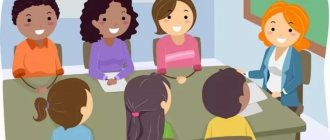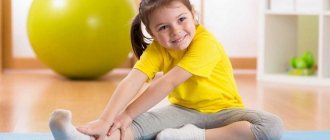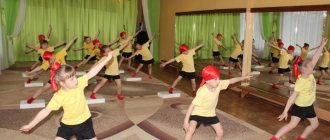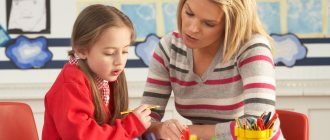The issue of protecting and strengthening the physical condition of children is considered one of the most important in almost all kindergartens. In this direction, work is carried out based on compliance with requirements and sanitary and hygienic standards, the correct approach to organizing a balanced diet, systematic hardening of children, as well as physical education and health activities.
Today, physical education for children in preschool educational institutions is of particular importance. According to statistics, in Russia in recent years the number of children aged from 3 to 7 years who are distinguished by functional deviations in health has increased to 60%. The main task of the kindergarten is the correct individual approach to each child in order to positively influence the current situation.
The importance of physical education in kindergarten for ordinary children and children with disabilities
For most children, physical education is an opportunity to become full-fledged members of society in the future. If you correctly engage in physical exercises with a preschool child with a problem that they understand, he will learn to interact with his peers, striving for his first achievements and development.
As for children with disabilities (Limited Health Opportunities), there is an individual approach for them, taking into account the following features:
- correctional and compensatory work. It involves the selection of exercises, taking into account the main and possible associated ailments. In this case, it is customary to use an integrated approach that promotes the development of physical abilities;
- preventive measures. This part is one of the most important, as it allows you to increase vitality, as well as health, improve overall well-being and strengthen the immune system;
- psychology. Often the main reason for a child’s antisocial behavior is lack of self-confidence and self-confidence. As a result, the child does not understand his role in society and does not know how to interact with peers. Therefore, an integrated approach is designed to help the child overcome such problems;
- physical education with children with disabilities in preschool educational institutions also includes educational upbringing. This means that all children with similar problems should be taught sports culture, as well as the rules of competition, which will help them gain the skills to work with other children in a team and subsequently make sports an integral part of their lives.
Note! The main exercises for children with disabilities include activities that are aimed at acquiring the most important everyday skills, which include fine motor skills of the hands, micro-orientation, and leg movements.
All these exercises are always based on provisions about the physical and psychological characteristics of the baby, as well as special methodological principles for working with each of them. For a child without disabilities, physical exercise also plays a very important role. Exercise not only promotes health, but also physical development. Physical education can help mental activity and also has a beneficial effect on the body as a whole. In this regard, educators take the following measures:
- Morning work-out. It always has a beneficial effect on increasing performance and also improves well-being for the whole day.
- Short bursts of physical exercise. They are designed to relieve fatigue and increase mental capacity in order to relieve the child from the feeling of overwork.
- Various types of hardening with parental permission. Holding physical education holidays, which are designed not only to improve well-being, but also to promote physical development, have a positive effect on the emotional state of the child, which in the future will help him perceive physical exercise as a way to improve his mood.
- In addition to morning exercises, this includes such types as finger, articulation and breathing.
- For each group, special physical activity regimes are always compiled, in which, in addition to organized varieties of physical education exercises, independent outdoor games are included in the daily routine of preschoolers, taking into account their individual and age-related characteristics.
Organization of classes
Physical education in kindergarten should contribute to the development of motor skills in children, create positive motivation for them, but above all, make them happy. To achieve this, the instructor, when organizing classes, must focus on the interests and abilities of the children, on current needs, as well as on the available premises and their equipment. In all this, the following principles must be observed:
- The physical education program should contain a large number of varied outdoor exercises and games, and it is also necessary to provide a sufficient amount of time to complete each exercise.
- Classes must correspond to the development of children, that is, it is necessary to exclude excessive or underestimated requirements.
- Children should be given ample opportunity to improve and develop their abilities and skills, as well as to practice independently.
- A physical education instructor in a kindergarten implements an individual approach to each child: subgroups of children are created based on their state of health and their pace of physical development; Children's well-being is monitored during classes; The content and load of classes changes in accordance with the characteristics of each child.
- It should be remembered that the best results can be achieved through repeated repetitions, but the best way to learn is through personal example.
- It is advisable to try to avoid drills when children are competing individually. It is better to organize team competitions.
Features of physical education in modern kindergartens
The physical development of the baby is the object of constant monitoring by specialists, both pedagogical and medical. Therefore, the task of each institution that draws up physical education projects in preschool educational institutions with children is to prepare such programs that will fully meet the requirements of these specialists.
Modern pedagogical practice allows for the only form of work with children, this includes traditional classes that contribute to achieving positive dynamics in the matter of the child’s physical development. All methods of conducting physical education exercises in preschool institutions are based on the need to solve 2 most important problems:
- organization of such a health complex that promotes the formation of an optimal sequence of movement and gradual increases in physical activity, which will further help strengthen the child’s immunity, and also have a positive effect on stimulating psychophysiological development. This will prevent the development of many pathological changes in the body;
- meeting age-related needs for physical exercise, which should be perceived by every child as “muscular joy”, and by educators as the main means of comprehensive development of preschool children. During such physical education classes, children not only understand the characteristics and capabilities of their body, but also communicate with peers through competitions in attentiveness and dexterity.
Implementation of classes for preschoolers
The preschool period lasts from 3 to 7 years. During this period, children's limbs grow rapidly. Speech is developing, the child begins to master skills and gain skills in interacting with the people around him. In order for the child to be ready for this, he needs to prepare for school. In addition, body movements become more perfect, aiming when throwing objects improves, running skills improve, and new elements of jumping and landing are mastered.
Preschoolers are not capable of prolonged physical activity due to rapid fatigue and insufficient skeletal strength. Training needs to be varied as much as possible, and activities should be implemented in the form of a game. The period of stress required for the body is already 15–20 minutes. For this age group, the following forms of exercise therapy are most suitable:
- outdoor games with elements of gymnastics;
- therapeutic exercises with a ball and fitball;
- swimming in the pool;
- wellness massages.
Standard sets of exercises
If a child constantly exercises, his appetite and activity increase throughout the day. All exercises are selected in such a way as to affect the muscles of the spine, neck, lower back, shoulders, limbs and pelvis. The main goal pursued by educators is to influence the strengthening of the musculoskeletal system, as well as the prevention of diseases such as scoliosis.
It is best to do exercises in the fresh air, which is what all educators try to do in the warm seasons, and in winter a ventilated room is well suited, usually a sports or music room. Gymnastics along with hardening have a very good effect on a child’s body. In the future, this has a positive effect on the baby’s immune system and resistance to many diseases.
The set of exercises includes three stages:
- introductory part. Exercises (rotations of the head, circular movements of the arms, turns of the torso, bending);
- basic exercises. Stretching the muscles of the arms, legs and back, squats with gradually increasing repetitions, push-ups (if possible);
- final part. Light jogging with a step, shaking the muscles to relax.
The first stage includes various types of walking, as well as running, which are necessary to gradually activate different muscle groups. Next, you can begin exercises that will help strengthen and strengthen muscles, as well as joint mobility, posture and coordination. As for the final part, this usually includes some types of gymnastics and moderate walking.
Benefits of exercise therapy for children
Physical activity is one of the fundamental conditions for proper development, but adults often do not pay attention to this indisputable fact. In addition to this, exercise therapy classes have the following advantages:
- children acquire hygiene skills, learn about the world around them and themselves in it;
- they are also useful for the harmonious growth of the spine;
- to form correct posture; to strengthen the muscles of the spinal column;
- to prevent and correct asymmetry during the progression of scoliosis;
- the condition of flat feet improves;
- qualities such as strength, endurance, agility are stabilized;
- the functions of the endocrine gland are normalized;
- immunity is strengthened;
- the processes of adaptation to unusual new conditions are accelerated;
- When carrying out exercise therapy, stress resistance is normalized.
Exercises used in classes
Physical exercises should be designed to enable children to experience different forms and possibilities of movement and to develop and improve the skills required for this. All classes must be conducted in a playful way.
You can use exercises in which children learn to climb, purposefully catch and throw, jump, move rhythmically, run fast, perform tasks in pairs, and use equipment (balls, jump ropes, ropes, mats).
When developing classes, do not forget that music is a big plus. Physical education in kindergarten using musical accompaniment helps develop a sense of tact and rhythm. And it just improves your mood. Exercises that are performed to the sounds of children's favorite songs bring great pleasure to children. After all, they can sing along and associate themselves with their favorite character.
methodology for conducting physical education classes in pre-methodological development
MBDOU "Novochurashevsky kindergarten "Kolosok"
Ibresinsky district of the Chuvash Republic
REPORT
On the topic of:
“METHODOLOGY FOR CONDUCTING PHYSICAL ACTIVITIES”
With. New Churashevo-2019
The main form of organized training in physical exercises in preschool institutions is physical education classes. At the same time, training in physical education classes is carried out in a certain system and sequence, which allows achieving the best results in the formation of motor skills.
In the process of physical education classes, children are prepared for successful learning at school, health-improving, educational and educational tasks are solved.
Classes, including gymnastic exercises and outdoor games, are usually held in the morning (30 minutes after breakfast). If the lesson is organized in the second half of the day, then it is advisable to start it immediately after a nap or while the children are in the fresh air.
Structure and content of physical education classes. Physical exercises in a lesson are arranged in a certain order, which is determined by the physiological and psychological laws of the body’s performance.
When performing physical exercises, a person’s performance increases gradually. Then it remains at the optimal level for some time, after which it begins to decline. Therefore, to perform complex exercises (high intensity and high speed running, jumping, throwing, etc.), you need to prepare all organs and systems of the body (skeletal, muscular, cardiovascular, respiratory, nervous). Otherwise, injuries (sprain, rupture of ligaments, muscles), as well as dysfunction of body systems, including the nervous system, are possible. In turn, insufficient preparation of the nervous system can affect the process of perception and assimilation of exercises, the quality of their implementation,
It is important to structure a physical education lesson in such a way as to ensure preliminary physical and psychological preparation of children to perceive and perform more complex exercises, with the help of which basic tasks are solved. Based on this, a physical education lesson is divided into the main and final parts. Each part solves certain problems, in accordance with which exercises are selected and alternated, and a methodology for their implementation is thought out.
The introductory part solves a psychological problem: organize children, collect and activate children’s attention, arouse their interest in the lesson, and create a cheerful mood. For this purpose, drill exercises, various types of walking and running, jumping on two and one legs in place and with advancement, exercises and games for attention, elements of dancing and dancing are used.
This part of the lesson provides general and special preparation of the body for performing more complex exercises, which are planned in the main part of the lesson, and for increased physical activity.
General training is best ensured by general developmental exercises that affect all muscle groups, as well as basic movements (walking, running, jumping), which enhance the activity of the cardiovascular and respiratory systems, as a result of which physical activity gradually increases.
Special training is aimed at “warming up” those muscles, ligaments, and joints that are involved in the first exercise performed in the main part of the lesson. For example, if such an exercise turns out to be a jump, then the leg muscles need to be prepared for this, and throwing will require the preparation of the muscles of the shoulder girdle and arms. Special training is solved with the help of general developmental and preparatory (such as lead-in) exercises.
In the main part of the lesson, motor skills and abilities are formed, physical qualities are developed. The sequence of solving these problems is determined by the characteristics of the nervous system of a preschool child: first, new exercises are learned when the child’s performance is at an optimal level. And after that, they consolidate the skills in the mastered movements and develop physical qualities.
The content of this part of the lesson consists of basic movements (running, jumping, throwing, climbing, etc.), games of high mobility, relay race games, and also, in some cases, elements of dancing. When several of the most complex movements are introduced into the main part of the lesson, then before each of them preparatory, leading exercises are given.
In the main part of the lesson, the most complex general developmental exercises can be learned. They are used as preparatory and lead-in exercises for the main movements, as well as for developing flexibility, strength, and coordination of movements.
After the main part comes the final part. Its purpose is to reduce physical activity, bring the child’s body into a relatively calm state, while maintaining a cheerful mood, and sum up the results of the lesson. To solve these problems, walking, running at an average pace, elements of dancing, general developmental exercises for the shoulder girdle, and active games of a calm nature (“Find the object,” “Find where it’s hidden,” etc.) are used.
The number of parts in each lesson and their sequence remain the same in all age groups. All parts of the lesson are interconnected; The content of the introductory and final part largely depends on the objectives of the main part.
Junior group.
Classes in the second junior group of kindergarten are held three times a week, their duration is up to 20 minutes. The room (hall, group room) is ventilated and wet cleaning is carried out beforehand. The floor surface must be dry after wet cleaning to avoid injury.
The introductory part (2-3 minutes) includes exercises that mobilize children’s attention and prepare them for the upcoming physical activity, serving as a small warm-up. These are exercises in walking, running, formations, with various tasks, sometimes with musical accompaniment.
Walking and running exercises are usually carried out in alternation. First, walking is suggested - about half and a third of the “circle”, and then running a full “circle”, and the tasks are repeated. The concept of “circle” is conditional; except for special walking and running, it really is in a circle. You can place landmarks in the corners of the hall (small objects - cubes, skittles (except flags on a stick)) to make it easier for children to navigate.
Constructions and rearrangements develop children's spatial orientation and help them comprehend their actions.
After several lessons, the teacher suggests forming a line, a column in small groups in a circle, using landmarks (cubes, balls, cords, etc.)
The main part (12-15 minutes) includes gymnastic exercises of a general developmental nature with and without various objects; basic types of movements (balance exercises, jumping, climbing and throwing), outdoor play.
To perform general developmental exercises, constructions can be different and performed according to landmarks (cubes, balls, skittles), especially at the beginning of training.
The teacher pays special attention to the correct starting position of the legs, as this determines the overall load on the body and individual muscle groups.
When carrying out general developmental exercises in a standing position, as a rule, two positions are used - stand with the feet at the width of the feet and at the width of the shoulders. The teacher performs tilts and turns with the children 1-2 times. Next, the kids continue to perform the exercise independently as directed by the teacher. Basically, the teacher demonstrates the exercises himself, and some of them can be demonstrated by the most prepared child. After the demonstration and explanation, the children perform jumps on their own, and the teacher sets the rhythm - this can be hitting a tambourine, clapping their hands, or musical accompaniment.
For one week of every month, it is advisable to carry out general developmental exercises without objects. Other classes use a variety of equipment. This makes the exercises more interesting and allows you to vary the same tasks.
When drawing up a long-term lesson plan, the teacher outlines exercises for learning, repetition and consolidation. More time is allocated for completing training exercises; repetition of familiar material does not require detailed explanation, and only some clarifications or partial demonstration are expected.
In the second junior group, two types of basic movements are usually planned in one lesson. Increasing the set of basic movements can reduce the quality of assimilation of exercises.
Outdoor play is the culmination of the lesson in terms of physical and emotional stress on the child’s body.
Final part (2-3 minutes). After active play, children must be brought into a relatively calm state and only after that can they move on to other types of activities. As a rule, the final part of the lesson includes simple exercises, low mobility games, and round dances.
Middle group
In the middle group of kindergarten, physical education classes are held three times a week in the morning; The duration of the lesson is 20-25 minutes. The room in which children study must be prepared in accordance with hygienic requirements (wet cleaning, ventilation), and the necessary equipment must be selected in advance. Every third lesson during the week is held outdoors, on the playground.
During physical education classes in the hall, children wear physical education uniform (T-shirt, shorts, socks, Czech shoes). Children do not specifically change clothes for activities on the site, but during activities, clothing should be lightened. In winter, it is advisable for children to wear jackets, leggings, and knitted hats. Clothing during walking classes must comply with hygienic standards and requirements.
Physical education classes in the middle group are conducted according to a generally accepted structure, consisting of introductory, main and final parts, each of which, having specific tasks, is subordinated to a single goal - the comprehensive and harmonious development of various motor skills and abilities.
The introductory part (3-4 minutes) prepares the child’s body for the upcoming more intense load. Exercises are used in walking, running, various simple tasks with objects, exercises that strengthen the muscles of the legs and feet, forming correct posture.
When carrying out exercises in walking and running, it is necessary to observe their appropriate alternation, without getting carried away with walking exercises. Walking for a long time tires children and adversely affects their posture. The duration of running for children 4-5 years old in classes varies. At the beginning of the year, running is carried out 2-3 times for 20-25 seconds. in alternation with walking, by the middle of the year the duration of running can be increased to 30-35 seconds.
The main part (12-15 minutes) is aimed at solving the main tasks of the lesson - teaching children new exercises, repeating and consolidating previously covered material, mastering vitally important
our motor skills and abilities, development of physical qualities: agility, strength, speed, endurance, etc.
The content of the main part of the lesson includes general developmental exercises, exercises in basic types of movements and outdoor games.
General developmental exercises with objects (flags, cubes, skittles, braids, sticks, etc.) and without objects are carried out in a certain sequence: for the muscles of the shoulder girdle, back muscles and oblique abdominal muscles (bending, turning) and legs. In the middle group, 5-6 exercises are offered, 5-6 repetitions 5 to 6 times.
When conducting general developmental exercises, various types of formation are used: in a circle, around objects pre-arranged in a checkerboard pattern; scattered; in two or three columns.
The teacher checks the correct starting position in each exercise of a general developmental nature so that the physical load is distributed evenly across all muscle groups.
The starting positions are different: stand with your feet the width of your feet, shoulders, sitting with your legs apart, in a kneeling position, lying on your back and stomach, etc. You should pay attention to
sequential transition from one starting position to another.
In this part of the lesson, basic movements are taught: jumping, balance, throwing and climbing. In one lesson, as a rule, two, sometimes three main types of movements are offered, not counting the exercises used in outdoor play.
The final part (3-4 minutes) should provide the child with a gradual transition to a relatively calm state, especially after active play.
Senior and preparatory group
CONTENT AND STRUCTURE OF CLASSES
The duration of outdoor activities corresponds to program recommendations. The structure of the classes is traditional: introductory, main and final parts.
The introductory part begins with building on the playground and walking, during which children perform 3-5 breathing exercises. During the cold season, construction is not carried out on the playground and the introductory part begins with the children leaving the room and going outside. After a short walk, a slow run around the area is given for 2-4 minutes (depending on age). In this part of the lesson, children are prepared for upcoming muscular activity and taught mainly various types of running: with a wide step, raising the knees high, side step, back forward, in pairs, scattered, etc. Jumps are also performed on one and two legs, with legs on legs, etc. The use of these exercises is aimed at improving spatial orientation, strengthening the muscles of the legs and pelvis, and improving posture. The run ends with walking and changing into a steep or column formation.
The main part of the lesson begins with performing a set of general developmental exercises. At the end, the children line up in a column one at a time, put away the used sports equipment along the way and run at an average speed, depending on age, from 40 s to 2 minutes. The run ends with walking in formation to perform the exercise in the basic movements.
At each lesson, children practice several basic movements. A new or more difficult to coordinate movement is performed first. Then the children run again at average speed, after which they practice another movement that is already familiar to them. Exercises in basic movements end with a slow run, then an outdoor game or relay game is organized. The games involve reinforcing one of the basic movements; Running plays a big part in them. The game is repeated 4-5 times, the pauses between repetitions are short.
The final part involves a slow run.
If children run a lot during the game (“Traps”, “Planes”, etc.), then in the final part the duration of the slow run is not indicated, but it should be less than usual (no more than 1-1.5 minutes) . Slow running turns into walking, during which 6-8 breathing exercises are performed. This ends the lesson








